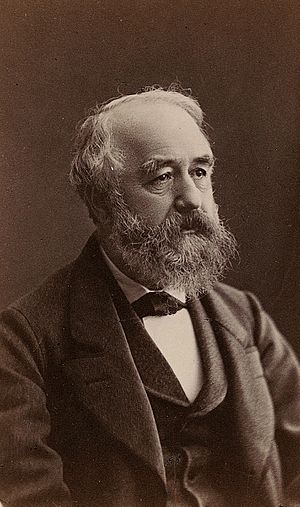Rudolf Wolf facts for kids
Quick facts for kids
Rudolf Wolf
|
|
|---|---|

Rudolf Wolf
|
|
| Born | 7 July 1816 |
| Died | 6 December 1893 (aged 77) |
| Nationality | Swiss |
| Alma mater | University of Zurich |
| Known for | Wolf number |
| Scientific career | |
| Fields | Astronomy |
| Institutions | University of Zurich |
| Doctoral advisor | Encke |
Johann Rudolf Wolf (born July 7, 1816 – died December 6, 1893) was a smart Swiss scientist. He was an astronomer and a mathematician. He is most famous for his studies of sunspots.
Contents
Early Life and Education
Rudolf Wolf was born in a town called Fällanden, near Zurich, Switzerland. He went to several universities to study. He learned at the universities in Zurich, Vienna, and Berlin. One of his important teachers was a scientist named Encke.
A Career in Science
Wolf became a professor of astronomy in 1844. This was at the University of Bern. A few years later, in 1847, he became the director of the Bern Observatory. An observatory is a place with telescopes to study space. In 1855, he moved to Zurich. There, he became a professor of astronomy at both the University of Zurich and the Federal Institute of Technology.
Discovering Sunspot Secrets
Rudolf Wolf was very interested in Heinrich Schwabe's discovery. Schwabe had found out that sunspots follow a cycle. Sunspots are dark, cooler areas on the Sun's surface. Wolf started to watch sunspots himself. He also gathered old information about sunspots. He looked at records going all the way back to 1610!
The Wolf Number
From all this data, Wolf figured out the sunspot cycle lasts about 11.1 years. In 1848, he created a special way to measure sunspot activity. This measurement is now called the Wolf number. Scientists still use it today to track how active the Sun is.
Sunspots and Earth
In 1852, Wolf and three other scientists made another big discovery. They found a connection between the sunspot cycle and Earth's magnetic field. This is called geomagnetic activity. It means that what happens on the Sun can affect our planet.
Other Scientific Work
Around 1850, Rudolf Wolf also did experiments with probability. Probability is about how likely something is to happen. He did a famous experiment called Buffon's needle. He dropped a needle 5000 times onto a plate. He did this to check the value of π. This experiment was an early step toward a method called the Monte Carlo method. This method uses random numbers to solve problems.
See also
 In Spanish: Rudolf Wolf para niños
In Spanish: Rudolf Wolf para niños

